
УДК 338
DOI 10.24411/2413-046Х-2019-10215
ЗАВИСИМОСТЬ РОСТА ВВП РОССИЙСКОЙ ФЕДЕРАЦИИ ОТ ВЛИЯНИЯ ЦИФРОВОЙ ЭКОНОМИКИ
DEPENDENCE OF GDP GROWTH OF THE RUSSIAN FEDERATION ON THE INFLUENCE OF THE DIGITAL ECONOMY
А.О. Кривошеева, Финансовый университет при Правительстве Российской Федерации, Факультет Международных Финансов
Научный руководитель: доктор экономических наук, профессор Трегуб И. В.
Аннотация: Современные процессы, происходящие в мировой экономике отчетливо указывают на тенденции к цифровизации процессов. Сравнивая разные страны можно заметить, что не во всем мире развитие движется единым темпом. Кроме этого, очень важным фактором и идентификатором уровня развития страны является ее ВВП. В данной статье проанализировано современное состояние развитие цифровых технологий в России, выделены факторы цифровизации влияющие на ВВП и на их основе осуществлен корреляционный анализ. И выявлены ключевые перемены, оказывающие существенное влияние на рост российской экономики.
Summary: Modern processes taking place in the world economy clearly indicate trends towards digitalization of processes. Comparing different countries, it can be noted that development is not moving at the same pace all over the world. In addition, a very important factor and identifier of the level of development of the country is its GDP. This article analyzes the current state of the development of digital technologies in Russia, identifies the factors of digitalization affecting GDP and on their basis carried out a correlation analysis. And identified key changes that have a significant impact on the growth of the Russianeconomy.
Ключевые слова: цифровая экономика, ВВП, экономический рост, переменные цифровизации, НИОКР, рост ВВП.
Keywords: digital economy, GDP, economic growth, digitalization variables, R & d, GDP growth.
Currently, the Russian Federation faces the global challenge of moving from a commodity economy to digitalization. As the results of other leading countries (such as the USA, Singapore and Israel) show the development of the digital economy has a positive effect on the level of GDP. For the development of the economy in the digital age a very large number of factors are taken into account. For example, this is human capital, the level of education, the regulatory framework, and so on.
According to experts at McKinsey, by 2025, GDP in Russia is expected to grow by 4.1–8.9 trillion rubles. Such growth can only be through digitalization. And the experience of other countries illustrates that it is the truth.
Digitalization will provide from 19 to 34% of Russia’s GDP growth, and the share of the digital economy itself can be 8-10% in GDP.
To analyze the current situation we need to pay attention on figures on 2015-2018 years: The country’s GDP from 2013 to 2018 increased by 7%, and the digital economy over the same period increased by 59%, to 1.2 trillion rubles. Thus, over these five years, the digital economy accounted for 24% of total GDP growth. The growth is represented on diagram below:
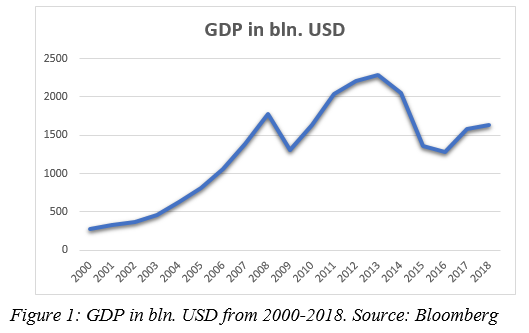
Next, I need to provide a more detailed description of what areas are included in the economy and allow you to measure it in numerical terms. The graph below illustrates Russia’s lagging behind the European Union in these key parameters.
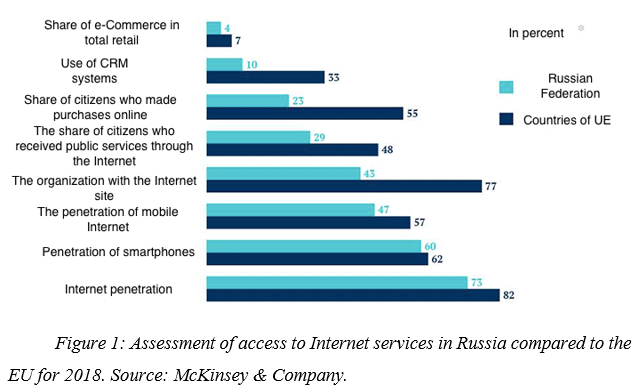
As you can see there are no parameters where the Russian Federation has the leading position. So, the goal for the medium term (2020-2025) should be the tripling of the digital economy. In addition, such a goal can be achieved if the state plays ahead of the curve, which means quickly adapting and implementing technological achievements. In particular, the role of the state in promoting innovation, the extensive development of digital public services, co-financing promising projects (through public procurement) and increasing digital literacy of the population. In addition, the issue of training “digital” personnel is acute. For our country, it is a key but difficult goal. We have a big gap in comparison with other countries. In this graph, you can see the level of development of digital economy of different countries.
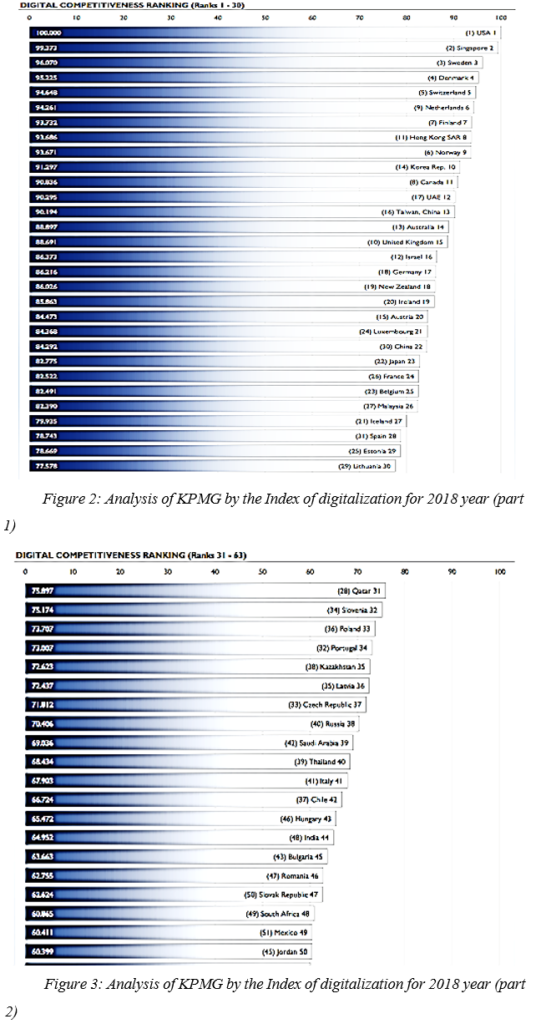
As we can see from tables, Russia takes only the 40th place, which represents the gap between leading countries and Russian Federation. We need to increase the speed of our development to fulfill the gap.
To achieve this goal we need to increase the number of projects in R&D because it is possible to create good Russian innovative products.
Since R&D costs are necessary in a short time and in large volumes, the state is the main investor in this area. If we talk about Russia, then R&D is supported in the majority by the state and is controlled. In general, R&D is a set of activities aimed at the creation, production and final receipt of a new, competitive product. In the period of aggravation of political conflicts and the introduction of complete import substitution processes, the creation of innovative domestic products is necessary as soon as possible. In relation to GDP growth, many different indicators can be applied. But since current trends suggest that the digitalization of the economy leads to a significant increase in GDP, we will take exactly this factor.
The problems that are presented in the Russian economy are diverse. But one of the most important is the separation from world leaders in the development of innovative processes in the economy. Also, the problem of increasing GDP is no less relevant. The necessity of independence, the development of the army and import substitution also all affect Russian economy. Experts estimates various factors that affect GDP. But the most attractive for them is digitalization and innovation at all stages of product creation.
It is very important to identify the problem that will be solved using econometric analysis. Since the choice of variables strongly depends on this.
We know that in Russian Federation R&D projects depend on the budget. And, if we want to increase the level of digitalization we need to invest money in R&D. But, it is necessary to be sure that investments will show good results on the economy, and particularly in GDP numbers. Because nowadays in Russian Federation experts have different points of view. The first part supports investment in R&D projects and believe in future increase of GDP. Another part assumes uselessness of these projects, innovation economy and e.t.c. So, to poof the dependence we need to find the correlation and present our results.
To assess the impact of digitalization on GDP, it is necessary to take into account not only the numerical manifestations, but also to introduce the criterias of the presence of technology. So, in order to prove the relationship between GDP and digitalization, I choose the following Endogenous variables:
1) domestic current expenditure on R&D at actual prices, mln rubles.
2) average annual number of employees in the Russian Federation by type of economic activity, namely in research and development, thousand people.
3) Number of developed advanced production technologies new for Russia
4) Number of personal computers
5) The cost of information and communication technology
The time series data was taken from Bloomberg financial laboratory for the period 2000-2018, also from Russian Statistical data and from the statistical research on new technologies in Russia.
To analyse the dependence of GDP (bil. rub) on internal current expenditures on research and development (R&D) (million rub), the average annual number of people employed in the Russian Federation by type of economic activity, namely in research and development (thousand people) a sample of n = 18 was selected for the period 2000 to 2018, the results of which are shown in the table. So, we can construct correlation analysis table for these variables that will show us correlation between them. However, before it is better to illustrate diagrams, which represents the correlation between the most correlated variables:
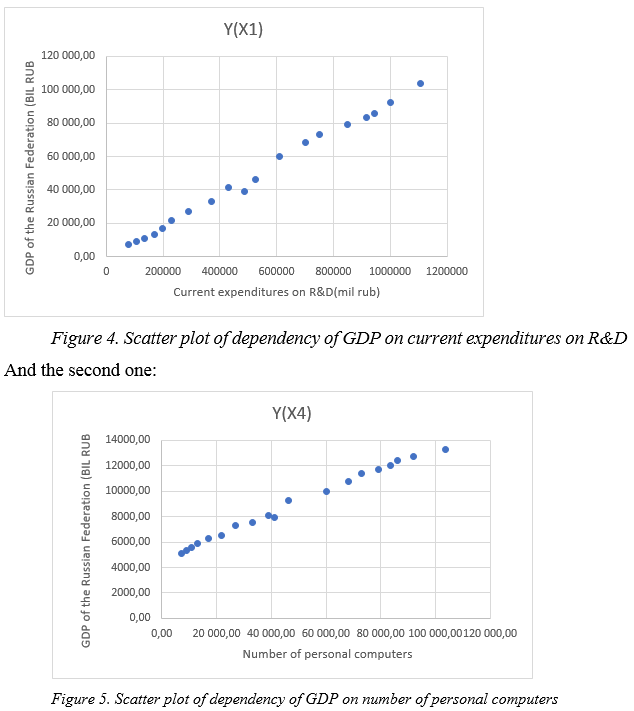
These scatter-plots illustrates positive correlation because pots are located nearby increasing line, with the increase of internal current expenditures GDP growths and increase too. We can explain in by the results of R&D activity which are implemented in process of production and helps to decrease costs and expand profit which reflect on GDP growth of country. Computers affect on speed of sales and it also increases GDP. So, it is important to mention that this is seems like strong correlation in both cases. All other scatter plots will be added on notes. Then we need to find pair correlation and by the Excel function we get the following Matrix:
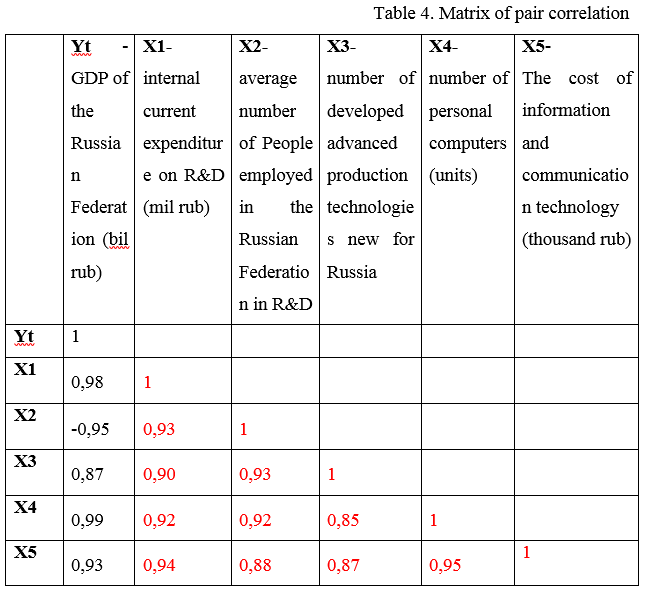
All correlation coefficients for all pair are more than 0,8 so we can conclude that there are strong correlation. But, the dependence between GDP and The average number of people employed in R&D in the Russian Federation are strong negative.
All variables are important for GDP and influence a lot on it.
After selecting the variables and analyzing them, we can draw the following conclusions: there is a large correlation between all the variables. All this suggests that digitalization still has a great impact on GDP. As we can see the highest levels of impact are connected with current expenditures on R&D.
All in all, as my research were conducted to analyze and find out the most important factors of digitalization I can conclude that in my work I proved the dependence of GDP of digitalization in different types. The most important factor is R&D projects, while others has also high correlation and it means that they are also important for GDP. So, we can conclude that investments in R&D projects are useful and profitable in the future. It is possible to increase Russians GDP by digital economy as I assumed in the first part of my work.
References
- Вестник Челябинского государственного университета. 2018. // No 12 (422). Экономические науки. Вып. 63. С. 108—136.
- «Digitalization and economic growth: A comparative analysis of Sub-Saharan Africa and OECD economies”-by Godwin Myovella, Mehmet Karacuka, Justus Haucap 2019.//Telecommunication Policy, 26 September, 2019.
- G. Rakica, D. Milenkovicb, Information system for e-GDP based on computational intelligence approach // Physica A: Statistical Mechanics and its Applications. Volume 513, 1 January 2019, Pages 418-423
- Трегуб И.В. Эконометрика на английском языке. Учебное пособие. М.: РУСАйнс. 2017. 164p.
- Tregub I.V. Econometric studies. Practical examples. M.: Lan 2018. 164 p.
- Tregub I.V. Econometrics. Model of real system М: PSTM. 2016. 164 p.
- Tregub I.V. International diversification. М.: PSTM. 2015. 180 p.
- Tregub I.V. Econometrics G. Mange’s model for the BRICS countries // В сборнике: Forum for Reseach in Empirical Internation Trade Сан Рафаэль, 2015
- Tregub I.V. The capital market model on the example of Norway // В сборнике: Forum for Reseach in Empirical Internation Trade Сан Рафаэль, 2015. http://www.freit.org/WorkingPapers/Papers/Development/FREIT877.pdf
- Tregub I.V. Cointegration Models of The BRICS Economies. http://www.freit.org/WorkingPapers/Papers/Development/FREIT1079.pdf
- Tregub I.V. Keynesianism and modern economy. http://www.freit.org/WorkingPapers/Papers/Development/FREIT984.pdf
- Tregub I.V. Digital economy: Model for optimizing the industry profit of the cross-platform mobile applications market / Tregub I., Drobysheva, N., Tregub, A. // Advances in Intelligent Systems and Computing. 2019
- Трегуб И.В. Математические модели динамики экономических систем. Москва, 2009.
- Трегуб И.В. Прогнозирование экономических показателей на рынке дополнительных услуг сотовой связи. Финансовая акад. при Правительстве Российской Федерации, Каф. Мат. моделирование экономических процессов. Москва, 2009.


